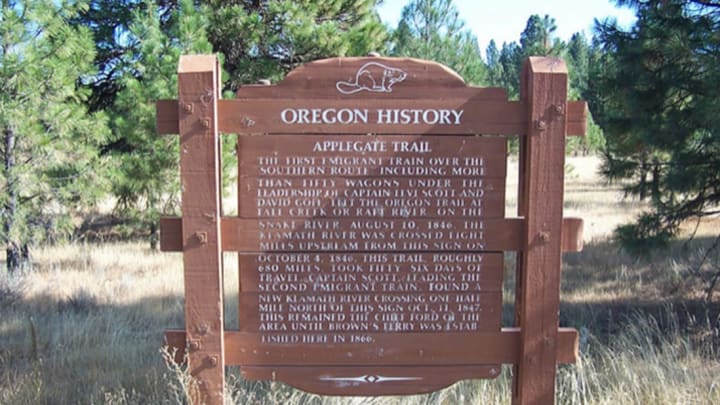For emigrants traveling west from the 1840s through the 1860s, the Oregon Trail was a harrowing but necessary route. Looking for better economic opportunities than the ones available in the Midwest, approximately 350,000 to 500,000 people traversed more than 2000 miles during those years. These farmers, miners, ranchers, and settlers risked accidents, infectious diseases, drowning, and starvation on the trail; approximately 10 percent of them died. Motivated by these hardships, Jesse Applegate, one of these settlers, established the Applegate Trail, a safer route for settlers to take from the Midwest into Oregon.
Born in 1811 in Henry County, Kentucky, Jesse Applegate was the youngest of nine children. His parents, Daniel and Rachel Applegate, farmed the 100 acres of land that Daniel received from the government for his service in the Revolutionary War. In 1821, the Applegate family moved to Saint Louis, Missouri. Jesse went to Rock Spring Seminary in Illinois for a year and then worked as a teacher and land surveyor. In 1831, he married Cynthia Ann Parker and ran a farm in St. Clair County, Missouri.
In 1843, Jesse Applegate and his two older brothers, Charles and Anthony “Lindsay” Applegate, decided to move with their families to Oregon for better farming and economic opportunities. They were some of 1000 people who packed their belongings in wagons and set out west from Elm Grove, near Independence, Missouri. This migration would later be known as the Great Migration of 1843, because it was the first time that a large group of settlers traveled together on the Oregon Trail. The Applegates brought 100 livestock—oxen, cows, horses—and supplies such as food, utensils, tools, and clothing in their wagons.
A fissure soon appeared in the group, however: Those traveling with cattle were slower than those without, and the latter group didn’t want to be bogged down by the former. So the group of 1000 people split into two, with Jesse Applegate leading the slower “cow column.” (The other group, sans livestock, was called the “light column.”)
On their journey across the Columbia River, a boat capsized, killing Jesse Applegate’s 9-year-old son Edward and 9-year-old nephew Warren. A 70-year-old man also died. It was then that the Applegates promised themselves they’d find a safer way for emigrants to get to Oregon, so that other families would be spared similar deaths.
The rest of the group survived the river crossing, and arrived at Fort Vancouver in Oregon in 1844. The Applegate brothers settled with their families on land in western Oregon. That year, Jesse Applegate put his surveying skills to use when he became surveyor-general of Oregon Colony (although some sources indicate that he refused the appointment, and did it on a contract basis instead). In 1845, he was elected to Oregon’s provisional government legislative committee, where he helped create Oregon’s early laws. Jesse Applegate also got to work to find a safer way for settlers to traverse the Oregon Trail.
Jesse Applegate’s son and nephew weren’t the only casualties of the Columbia River. Besides various isolated incidents, a whole family of travelers drowned in 1845. In his legislative role, Applegate influenced other lawmakers to let him survey the land around Oregon to find a less dangerous path. Between 1845 and 1846, he joined other Oregon residents to look for an alternative route into Oregon’s Willamette Valley, but they had trouble finding better options. In 1846, Jesse Applegate was elected the leader of another group of men, including his brother Lindsay, who would explore the land.

Hot Springs on the Applegate Trail. Image byEd Hunsinger via Flickr // CC BY-NC 2.0
The Applegates traveled 350 miles to find a southern route to Oregon, which went through Nevada and northern California. After locating this new route, Jesse and his men told travelers about it, and between 200 to 500 people followed his instructions. Jesse Applegate went ahead with some of his men to build a road for the wagons, but he left to get relief and supplies for the arriving emigrants. He was later criticized for this decision when an unusual rainstorm raged through the canyon for a week, killing 7 to 12 of the emigrants who had taken the new trail and leaving others without most of their possessions.
Although Applegate’s trail was criticized for not being safe enough, it was shortly improved with better markings and a clearer path. Oregon residents took the Applegate Trail to go gold mining in California, and the route gave another option to emigrants who wanted to settle in Oregon but avoid crossing the Columbia River.
In 1849, Jesse Applegate moved to southwestern Oregon with his family, where he built a cabin, planted an orchard, and raised cattle. He was a member of Oregon’s Constitutional Convention in 1857. As part of his political activities, Applegate banned dueling and in an 1865 address declared that everyone, male or female, white or black or Native American, should have the right to vote. In 1876, he tried (but failed) to run for U.S. Senate. Jesse Applegate died in 1888 at one his son’s homes in Oregon. In 1992, Congress designated the Applegate Trail as part of the California National Historic Trail.
